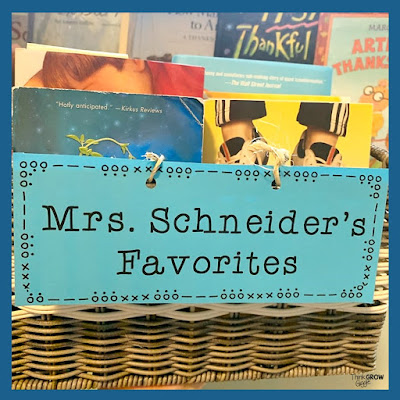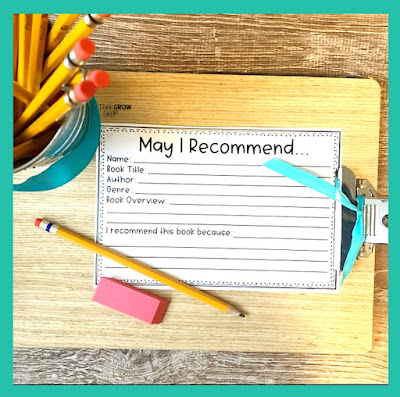As teachers it is in our very nature to love books! We love reading, learning, books of all shapes and sizes, and of course sharing that love of reading with our students. However, not every student that we work with loves books, or even likes them. Research shows this is primarily due to two reasons: the student was not read to as a young child and/or that student is a struggling reader.
My goal each school year is to always turn all of my students into readers, but especially I aim to reach those students who do not love, or even like, books when they first enter my classroom. These three simple ways have helped me to turn non-readers into readers who love and devour books.
Teacher Favorite Book Bin
 All it takes is a little tag on a basket that says your name! My students love to shop for books to read in the "Mrs. Schneider's Favorite" basket. I make sure that there are a variety of levels and genres in the basket at all times. I swap out the titles every three weeks or so, but leave staple titles in there that my kids always make a wait list for! Two series that they are willing to wait for are Doll People Series* (even my boys become obsessed with these) and The City of Ember Series*. I also like to mix in poetry books since their rhyming pattern is enticing to all readers, especially struggling readers. When I change the books in this basket I always make a quick announcement. I do not give a book talk and instead let them explore the books on their own.
All it takes is a little tag on a basket that says your name! My students love to shop for books to read in the "Mrs. Schneider's Favorite" basket. I make sure that there are a variety of levels and genres in the basket at all times. I swap out the titles every three weeks or so, but leave staple titles in there that my kids always make a wait list for! Two series that they are willing to wait for are Doll People Series* (even my boys become obsessed with these) and The City of Ember Series*. I also like to mix in poetry books since their rhyming pattern is enticing to all readers, especially struggling readers. When I change the books in this basket I always make a quick announcement. I do not give a book talk and instead let them explore the books on their own. Previously Read Bucket
 Having a previously read bucket is a serious classroom game changer! I cannot live without my previously read classroom library bucket. The concept is very simple. Get a large bucket and label it "Previously Read Together." After you read a book aloud, picture book or chapter book, it goes in the previously read bucket. Struggling readers consider these books "safe" because they have already heard the story, discussed the important elements, and have comprehended the text. Struggling readers love to grab a book from the previously read basket. It builds their confidence as readers and helps them make connections as they read these stories. I love to go to the previously read basket myself, to help save time with my mini- lessons!
Having a previously read bucket is a serious classroom game changer! I cannot live without my previously read classroom library bucket. The concept is very simple. Get a large bucket and label it "Previously Read Together." After you read a book aloud, picture book or chapter book, it goes in the previously read bucket. Struggling readers consider these books "safe" because they have already heard the story, discussed the important elements, and have comprehended the text. Struggling readers love to grab a book from the previously read basket. It builds their confidence as readers and helps them make connections as they read these stories. I love to go to the previously read basket myself, to help save time with my mini- lessons!Book Reviews and Recommendations
 There is nothing more powerful that the influence of a peer. Positive peer pressure helps keep students on track, working hard, and reading new books in my classroom. Before students start sharing book recommendations I model my expectations. Students fill out a recommendation card (grab these for free at the bottom of this post) and sign up to share. The sign up sheet is available to students the first of each month and has four sign up slots, one for each Thursday during morning meeting. The slots do go fast, and often times students ask me to open up more slots. While strong readers are the ones who usually share the first month or two of school, by the third month, all readers feel comfortable signing up and recommending books to others.
There is nothing more powerful that the influence of a peer. Positive peer pressure helps keep students on track, working hard, and reading new books in my classroom. Before students start sharing book recommendations I model my expectations. Students fill out a recommendation card (grab these for free at the bottom of this post) and sign up to share. The sign up sheet is available to students the first of each month and has four sign up slots, one for each Thursday during morning meeting. The slots do go fast, and often times students ask me to open up more slots. While strong readers are the ones who usually share the first month or two of school, by the third month, all readers feel comfortable signing up and recommending books to others. I also love using book talks in the classroom! These are a more formalized way to get all students talking about the books that they are reading with their peers. I even use these as a reading grade.
When it comes to instilling a love of books within your students make sure you celebrate every student reading success, big or small! Read aloud every day, share what you are reading, and implement these three simple strategies and your students will be loving books in no time.
Looking for more book recommendations? Follow along on Instagram where I share my favorite books each week, old and new titles are always shared!
Check out these other AMAZING ideas for turning your students into avid readers!
Using Picture Books in Science //Samson's Shoppe
How to Promote a Love of Reading In Your Classroom //The Stellar Teacher Company
Creating a Passion for Reading During Science //The Owl Teacher
Strategies to Help Motivate Reluctant Readers //The Little Ladybug Shop
*affiliate links: “Think Grow Giggle is a participant in the Amazon Services LLC Associates Program, an affiliate advertising program designed to provide a means for sites to earn advertising fees by advertising and linking to Amazon.” (source: Section 5)



















